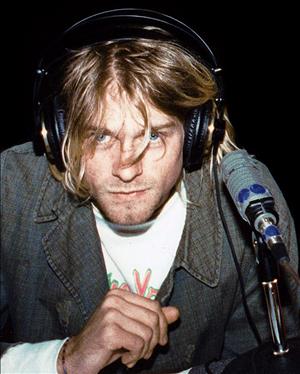On April 5, 1994, Kurt Cobain (1967-1994) commits suicide at his home at 171 Lake Washington Boulevard in Seattle. His body is not found until April 8, when it is discovered by an electrician. The 27-year-old singer, guitarist, and songwriter had risen to stardom with the Seattle-based band Nirvana, and is survived by his wife Courtney Love (b. 1964) and daughter Frances Bean Cobain (b. 1992).
Warning Signals
In early 1994, Nirvana began a European tour, but in March Cobain overdosed in Rome on painkillers and alcohol, which sent him into a coma. After spending three days in the hospital, Cobain returned home to Seattle with his wife, Courtney Love, and their daughter, Frances Bean. Nirvana canceled the rest of the tour.
Because of Cobain's heroin use, Love and some of Cobain's friends held an intervention, urging him to enter a residential rehab program in California. Love left for Beverly Hills on March 26, and Cobain followed a few days later, but not before buying a shotgun from Stan Baker Sports.
After spending two days at the Exodus Recovery Center in Marina Del Ray, Cobain climbed over a wall and disappeared. Love and friends drove around Los Angeles looking for him, but Cobain had flown back to Seattle, arriving there on April 2. Love, who remained in Los Angeles, filed a missing persons report with Seattle police on April 4.
A Grim Discovery
On the morning of April 8, an electrician arrived at Cobain and Love's home to install a security system. Upon climbing an outside staircase on the garage outside the house, the electrician spotted Cobain's body on the floor of a greenhouse above the garage. The electrician called the police.
When police arrived, they found Cobain's body lying prone with a shotgun atop his chest pointed at his chin. A suicide note lay nearby. Cobain had thrown his wallet on the floor, open to his Washington driver's license, but his body was so badly decomposed it eventually had to be identified through fingerprints. Coroners later determined the date of death to be April 5.
Word of Cobain's death traveled quickly. News photographers scrambled up the hill next to the garage, hoping to snap pictures of the police investigation inside. In less than an hour, Nirvana fans and curiosity-seekers had arrived, wondering if the news they heard was true. Reporters interviewed anguished fans for their reactions. Some were crying, some were angry, others were in disbelief.
By afternoon, the streets near the home were filled with people. Hundreds crowded Viretta Park, a small plot of public land next to the house. Throngs more came and went over the following days and even weeks. Many left flowers, written notes, and mementos.
Thousands Gather
On April 10, an emotional vigil was held at the Seattle Center, where more than 7,000 fans gathered near the International Fountain to pay tribute to Kurt Cobain. The event, half of which was underwritten by the City of Seattle, was organized by radio stations KNDD, KISW, and KXRX.
In a recording played at the vigil, Courtney Love read from Cobain's suicide note, her voice cracking with anger, responding to his words with her own. At the end of her message, she called Cobain a fucker, and urged the audience to do the same, but to also say they love him.
Nirvana bass player Krist Novoselic (b. 1965) read a more positive statement on behalf of the band. In it he stated, "We remember Kurt for what he was: caring, generous, and sweet ... Kurt had an ethic toward his fans, which was rooted in a punk rock way of thinking: No band is special, no player royalty. If you've got a guitar and a lot of soul, just bang something out and mean it. You're the superstar" (The Seattle Times, April 11, 1994).
Nirvana dissolved after Cobain's death, and bandmates Krist Novoselic and Dave Grohl (b. 1969) went on to pursue their own careers and causes. Every year on the anniversary of Kurt Cobain's death, fans still gather at Viretta Park to pay tribute.

